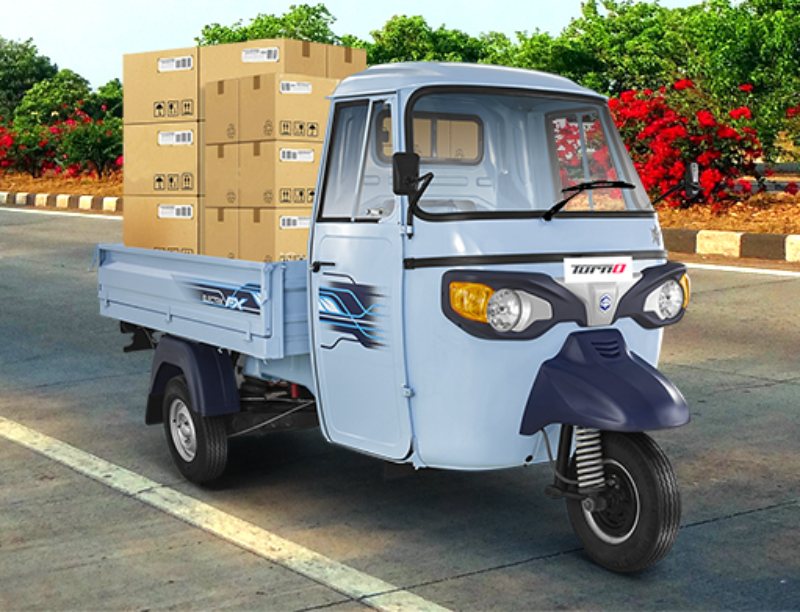The growing trend of electric commercial vehicles (EVs) signifies a significant shift toward more sustainable and environmentally friendly transportation options. Electric commercial vehicles are gaining popularity due to their numerous benefits, including reduced environmental impact and lower operational costs.

One of the key advantages of electric commercial vehicles is their positive impact on the environment. Unlike traditional vehicles powered by internal combustion engines, EVs produce zero tailpipe emissions during operation. This results in reduced air pollution, contributing to cleaner air quality and improved public health. By transitioning to electric commercial vehicles, businesses can play a vital role in mitigating climate change and reducing greenhouse gas emissions.
Furthermore, electric commercial vehicles have the potential to significantly decrease operational costs. Electric motors are highly efficient and require less maintenance compared to internal combustion engines, which have complex systems and require regular oil changes, tune-ups, and other maintenance tasks. Electric vehicles eliminate the need for expensive components like exhaust systems, spark plugs, and fuel filters. Moreover, EVs have fewer moving parts, reducing the likelihood of mechanical failures and minimizing repair costs.
In terms of fuel costs, electric commercial vehicles offer substantial savings. Electricity is generally cheaper than conventional fuels, resulting in lower per-mile operational costs. Additionally, governments and utility companies are implementing various incentives and programs to promote the adoption of electric vehicles, such as tax credits, grants, and discounted electricity rates, further reducing the total cost of ownership for businesses.
Electric commercial vehicles also benefit from regenerative braking, a technology that converts kinetic energy generated during braking into electricity, which is then stored in the vehicle's battery. This energy can be utilized to power the vehicle, extending its range and reducing energy consumption.
In summary, the increasing popularity of electric commercial vehicles is driven by their positive environmental impact and reduced operational costs. By embracing EVs, businesses can contribute to a cleaner, more sustainable future while reaping the financial benefits of lower maintenance and fuel costs.
EV vehicles Range and Loading Capacity
Payload capacity is vital for commercial applications as it directly impacts efficiency and profitability. Optimizing load distribution ensures efficient utilization of payload capacity without compromising stability. By implementing design strategies, utilizing lightweight materials, and optimizing load distribution, electric commercial vehicles can achieve higher payload capacities, enabling businesses to transport more goods efficiently while benefiting from electric propulsion. Payload capacity plays a crucial role in commercial applications as it directly impacts the efficiency and profitability of businesses. In the context of electric commercial vehicles (EVs), maximizing payload capacity becomes even more critical to ensure that the vehicle can carry the necessary goods or equipment while still benefiting from the advantages of electric propulsion.
Furthermore, the design of three-wheeler EVs can be tailored to maximize cargo space. Innovative storage compartments and flexible configurations can be incorporated to accommodate various types of cargo, ranging from parcels to perishable goods. This optimized design allows for efficient utilization of the available space, further enhancing the payload capacity of three-wheeler electric cargo EVs.
Challenges of Enhancing range and Payload:
Electric vehicles (EVs) face limitations in terms of range and payload capacity, which can impact the productivity and practicality of electric commercial vehicles. EVs typically have a limited driving range compared to traditional vehicles, which can be challenging for commercial applications requiring long-distance travel or continuous operation. The restricted range may result in downtime and disruptions if charging infrastructure is not widely available. Additionally, EVs often have reduced payload capacity due to the weight of the battery pack, limiting the amount of goods that can be transported in a single trip. This can lead to the need for multiple trips or additional vehicles, increasing costs and reducing efficiency. Overcoming these limitations requires advancements in battery technology to improve range and optimize vehicle design to minimize weight. The development of fast-charging infrastructure and efficient route planning strategies is also crucial. Addressing these challenges will be key to maximizing the productivity and practicality of electric commercial vehicles.
Benefits of Enhancing payload and Capacity:
Enhancing range and payload in electric commercial vehicles brings several benefits, including increased operational efficiency, reduced costs, and improved customer satisfaction.
Operational Efficiency: By enhancing the range of electric commercial vehicles, businesses can expand their operational capabilities. Increased range allows for longer trips and more extended periods of operation without the need for frequent recharging. This leads to improved efficiency in logistics and delivery operations, enabling businesses to cover larger distances and serve a wider customer base.
Reduced Costs: Enhancing the payload capacity of electric commercial vehicles allows for the transportation of larger quantities of goods in a single trip. This reduces the need for multiple trips or additional vehicles, resulting in cost savings on fuel, maintenance, and labor. Furthermore, increased payload capacity enhances resource utilization, maximizing the efficiency of each delivery and minimizing wasted space.
Improved Customer Satisfaction: Electric commercial vehicles with enhanced range and payload capacity can provide more reliable and timely deliveries. Businesses can meet customer demands more effectively, ensuring that goods are delivered on time and in sufficient quantities. This improved service level leads to higher customer satisfaction, loyalty, and repeat business.
In summary, enhancing the range and payload capacity of electric commercial vehicles offers increased operational efficiency, reduced costs, and improved customer satisfaction. These benefits enable businesses to optimize their operations, enhance their competitiveness, and provide better service to customers, ultimately contributing to their long-term success.
Optimizing Efficiency for Extended Range and payload Capacity
Efficiency, range, and payload capacity are interconnected factors in electric commercial vehicles (EVs) that significantly impact their performance and practicality. Optimizing efficiency is crucial for maximizing both range and payload capacity while ensuring the vehicle operates at its highest potential.
Advanced telematics and predictive analytics systems further optimize efficiency. These technologies collect real-time data on vehicle performance, energy consumption, and environmental conditions. By analyzing this data, businesses can identify patterns and trends, allowing them to make informed decisions to optimize efficiency. Predictive analytics can also assist in route planning, charging optimization, and load distribution, leading to enhanced range and payload capacity utilization.
Additionally, driver training and behavior modification are essential for energy conservation. Educating drivers on efficient driving techniques, such as smooth acceleration, regenerative braking utilization, and maintaining appropriate speeds, can significantly impact energy efficiency. Encouraging eco-friendly driving habits through feedback systems and incentives can promote energy conservation and extend the range and payload capacity of electric commercial vehicles.
Conclusion:
Advanced telematics and predictive analytics systems provide valuable insights into vehicle performance, energy consumption, and environmental conditions. By leveraging this data, businesses can make informed decisions regarding route planning, charging optimization, and load distribution, ensuring efficient operation and utilization of range and payload capacity.
Driver training and behavior modification also play a vital role in energy conservation. Educating drivers on efficient driving techniques and promoting eco-friendly habits can significantly impact energy efficiency, extending the range of EVs and maximizing payload capacity.
By combining these strategies, businesses can enhance the practicality and productivity of electric commercial vehicles. Optimizing efficiency not only benefits the environment by reducing emissions but also reduces operational costs and improves customer satisfaction through timely deliveries. As EV technology continues to evolve, further advancements in efficiency will drive the widespread adoption of electric commercial vehicles, revolutionizing the future of sustainable transportation.

FAQs:
1. How can the range of electric commercial vehicles be improved?
Ans: To improve the range of electric commercial vehicles in India, advancements in battery technology and the development of a robust charging infrastructure are necessary.
2. What are the challenges faced in enhancing the payload capacity of electric commercial vehicles?
Ans: Enhancing the payload capacity of electric commercial vehicles in India is challenging due to the weight of the battery pack. Innovative vehicle design, lightweight materials, and efficient load distribution systems are essential to maximize payload capacity.
3. How do lightweight materials contribute to enhancing payload capacity in electric three and four-wheelers?Ans: Lightweight materials like aluminum and carbon fiber composites reduce the overall weight of electric three and four-wheelers in India, thereby enhancing payload capacity and enabling efficient transportation of larger loads.
4. What factors affect the payload capacity of electric commercial vehicles?
Ans: Factors affecting the payload capacity of electric commercial vehicles in India include the weight of the battery pack, vehicle design, load distribution systems, and compliance with local regulations.
5. Are there any regulations or standards governing the payload capacity of electric commercial vehicles?
Ans: India has regulations and standards set by the Ministry of Road Transport and Highways (MoRTH) and the Automotive Research Association of India (ARAI) governing the payload capacity of electric commercial vehicles. Compliance with these regulations ensures adherence to payload capacity requirements and safety standards.



